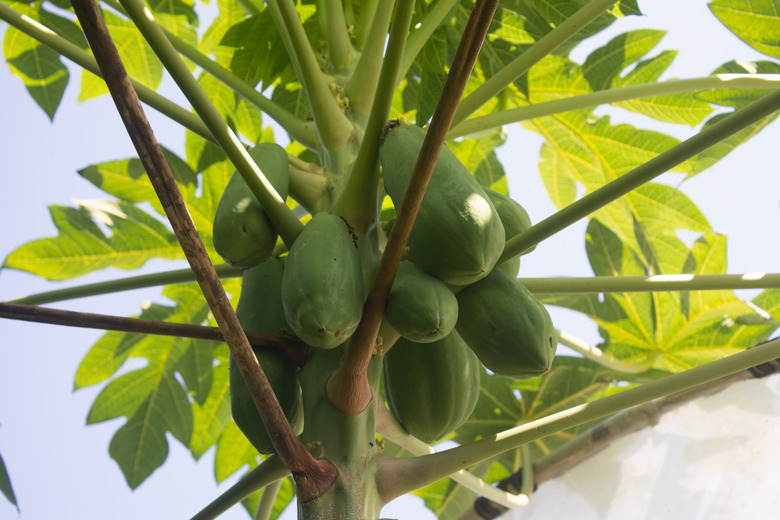Identifying Male And Female Papaya Trees
We may receive a commission on purchases made from links.
There is something about seeing fruit on a papaya tree (Carica papaya) that makes you long to sail off to tropical climes. Generally, these heat-loving plants are only hardy in U.S. Department of Agriculture plant hardiness zones 10 to 12, which limits their cultivation in the United States.
If you are lucky enough to live in warm areas of the U.S., like Hawaii, southern Florida, or the warmest parts of California, you may be able to cultivate papaya trees in a home orchard. Take care to have the right number of trees required to get both male and female flowers. This may be one tree or two.
Meet the Papaya Tree
Meet the Papaya Tree
The Hawaii-type papaya fruit is exotic, large, and pear shaped, with yellow skin and bright orange or pink flesh when ripe. The Mexican papaya has red skin. The trees that bear the fruit are equally unusual. They are evergreen and between 8 and 30 feet tall. Each tree grows a spiral of leafy branches at the top of a cylindrical trunk. These leaves can wilt when water is scarce. Like the trunks of palm trees, papaya tree trunks are also marked by leaf scars.
A single papaya tree can produce 100 or more fruit during a growing season. To do so, pollen from male flowers must fertilize the female flowers. This is pretty typical of angiosperms that reproduce sexually, but the exotic papaya adds an exotic twist to the equation since a single tree might have male flowers, female flowers, or both. Since pollination is essential to fruit, it's critical to know what type of flowers your papaya will bear.
Understand Sex and the Papaya Tree
Understand Sex and the Papaya Tree
The concept of sexual propagation is not new to any gardener. In most garden plants, female plants have female plant parts, like ovaries, that only produce fruit when fertilized by pollen from male plant parts, like anthers. A tree that is classified as male is one that only produces male flowers with pollen but no ovaries. A female tree is one that produces only female flowers with ovaries but no pollen.
With papaya trees, there are both male trees (with only male flowers) and female trees (with only female flowers). It's easy to understand that a garden would need one of each to get fruit, but that's not the end of the matter when it comes to papaya trees. There are also "hermaphrodite" papaya trees with flowers that have both an ovary and stamens (that bear pollen). These trees are self-pollinating, and you don't need a second tree to obtain fruit.
Identify Papaya Tree Gender
Identify Papaya Tree Gender
Fruit are the first thing for which to look when you want to identify the gender of your papaya tree. That's because although the trunk and leaves are the same for male, female, and hermaphrodite trees, male trees will not bear fruit.
In addition, look to the flowers. Male papaya flowers look very different from female flowers. On a male tree, you'll see many small, tubular blossoms, each with 10 pollen-producing anthers. They are held in groups at the end of long stems. The pollen is transported to female flowers by flying insects or wind.
Female papaya blossoms look very different. They are waxy and yellowish-white and are held on short-stalked branches. They have stigmas and ovaries to receive pollen from male papaya trees. The papayas mature three months after pollination. When flowers have pollen but also produce fruit, the tree is hermaphrodite and self-pollinating. These flowers are ivory white with bright yellow anthers and are borne on short stalks.
